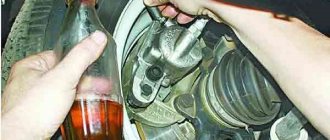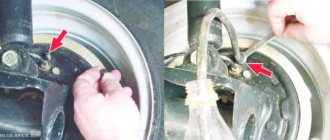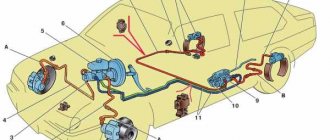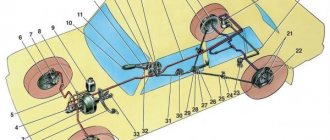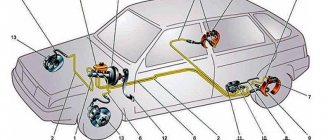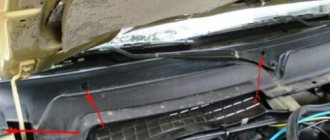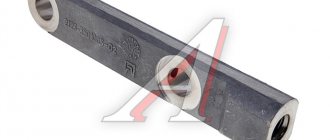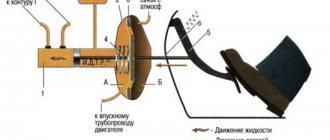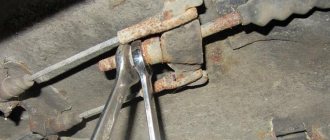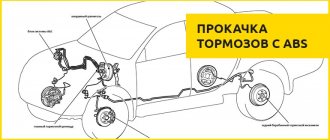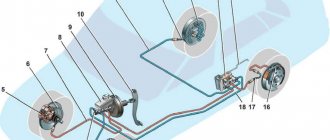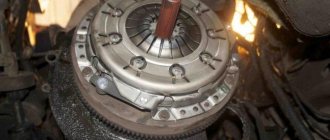From this article you will learn how to properly bleed the brakes on a Daewoo Nexia. At the bottom of the article there will be a diagram and video of bleeding the brake system.
Bleeding the brakes is a mandatory procedure if you change the brake fluid if your brake fluid level has gone low. (Usually, when the brake fluid level drops, this is indicated by a light on the dashboard. It lights up in the form of a red exclamation mark)
Bleeding will also be required if work has been done to replace elements of the brake system, for example, brake hoses, brake cylinders, calipers, brake pipes.
Bleeding the brakes is necessary to remove air from the car's braking system. If the brake pedal is sluggish or you have to press hard on the pedal for the brakes to work, and the brakes grab poorly and late. This means one thing - your brake system is airy, there is air in it.
When the brakes are pumped on a Daewoo Nexia
Naturally, the first signal of a malfunction in the brake system will be an inadequate response of the car to pressing the brake pedal.
Before bleeding the brakes, it is worth remembering the last time the brake fluid was changed.
The pedal may feel weak or sink almost to the floor, but there will be no effective deceleration. It is also worth looking at the brake fluid level warning lamp in the reservoir. A burning lamp will indicate that air has most likely already entered the system.
After any repair of the brake cylinders, main or wheel, it will also be necessary to bleed the brakes . The ultimate goal of the operation is to completely remove air from the system or completely replace the brake fluid. When fluid leaks, air can also enter through leaks in the brake lines and worn brake cylinder seals. In short, pumping technology will come in handy more than once.
Necessary tool
Pumping scheme
When bleeding the system, we will remove air from each circuit and from each working cylinder in strict order:
- Right rear wheel.
- Left rear wheel.
- Right front wheel.
- Left front caliper.
In the event that we repaired only one caliper or one working cylinder, most likely there is no need to bleed the entire system.
It will be enough to remove air only from the cylinder being repaired. Before starting work, do not forget to unscrew the reservoir cap and add fluid to the maximum mark. In addition, during the pumping process, we will monitor the liquid level in the tank and will not allow it to be more than half empty.
Before pumping, add brake fluid to the expansion tank using a syringe or bulb.
Pumping technology
If the car is equipped with an ABS system, then bleeding begins by turning on the ignition and pressing the brake pedal five times. After this, fresh liquid is added to the tank if necessary. When bleeding air from the rear cylinders, the ignition must be turned on. This is necessary so that the ABS hydraulic pump is activated and creates pressure in the circuit.
Otherwise, the pumping technology is no different:
- We ask the assistant to slowly press and release the pedal until it becomes elastic with maximum pressure resistance, the pedal is held in this position.
- Remove the protective cap from the fitting of the rear right cylinder, put a tube on it and lower it into a container half filled with liquid.
We clean the rear fitting from dirt and put the tube on it.
Bleed the brake cylinder until all the air is released.
We pump the remaining cylinders according to the order.
After pumping
After bleeding, add new brake fluid to the maximum level and close the reservoir with a lid.
We control the level of brake fluid in the expansion tank.
There are several nuances - when pumping, you need to press the pedal slowly and smoothly. Smoothly pressing the pedal eliminates the formation of emulsions (small air bubbles). The emulsion in the form of foam is almost impossible to dislodge from the system in the usual way. This is why pressing the pedal smoothly and slowly is of great importance.
How much brake fluid is needed for partial and complete replacement?
Maintaining the required level of brake fluid is necessary for the proper operation of the vehicle's braking system. How much is needed can always be found in the service book, but often car owners are not used to looking into it, but act empirically or look for the answer on the Internet. It is these users that we will try to help figure out the question of how much brake fluid is needed for replacement and which one should be poured.
Brake fluid is the working fluid of the brake system, with its help the force created in the master cylinder is transmitted to the wheel pairs.
If the brake fluid level is below the minimum mark (by the way, this will be indicated by the corresponding icon on the instrument panel - a red circle with waves inside), then you need to top it up.
It also doesn’t hurt to check the brake system, since a decrease in the brake fluid level may indicate a malfunction or wear of the master cylinder gaskets. As a rule, the brake system of a passenger car contains from 0.55 to 1.0 liters of brake fluid.
And its specification can very often be indicated on the body of the expansion barrel or its cover.
When checking, do not forget to pay attention to the color of the liquid . The new TJ is transparent with a yellowish tint. During operation, it changes its color and becomes dark, this is mainly due to the accumulation of various impurities. If the fluid has darkened, this may mean that a complete replacement is necessary and simple topping up is not enough.
Experts recommend replacing brake fluid approximately every 2-3 years , this is the optimal interval in accordance with hygroscopicity and exposure to temperature loads. For the brake mechanisms to function properly, the fluid must have a number of properties and also meet a certain standard.
Old and new brake fluid
Types and properties of fuel fluid
Any brake fluid has 93-98% of the main composition and from 2 to 7% of additives, which, in fact, are the key component for imparting the declared characteristics. In general, if you look at it this way, the properties of brake fluid depend on the combination of its components. Depending on the composition of the base, TJ is divided into 3 groups.
Types of brake fluids:
- Mineral (mineral oil LHM) . They consist of alcohol and castor oil.
- Glycolic . Developed on the basis of polyglycols and their esters.
- Silicone . Manufactured from silicon-organic polymer products.
Regardless of the type and composition, all brake fluids are divided into two classifications.
Classification of TJ:
- By viscosity.
- By boiling point:
- for “dry” liquid (without water);
- “wet”, which contains 3.5% water.
If the boiling point exceeds the permissible norm, then there is a risk of a vapor lock forming in the system (as a result of moisture evaporation), which can lead to breakdown and failure of the brake pedal.
Brake fluid standards
In practice, and in most cases, it is customary to use the American quality standard FMVSS No. 116 (Federal Motor Vehicle Safety Standard), which was developed by the US Department of Transportation (DOT for short). So, often, in modern cars, either DOT 4 is used on a glycol basis, or DOT 5.1 (including glycol and silicone compounds). But in cars manufactured more than 20 years ago, BSK or DOT 3 fluid can be used.
It is important to understand that DOT 5 fluid is chemically different from others, so it should never be mixed with DOT 3 or DOT 4, or used in systems designed for DOT 3 or DOT 4 fluids to avoid damaging the brakes.
The DOT standard clearly describes such characteristics as:
DOT 4 brake fluid (meets SAE J1703&J1704, FMVSS 116, JIS K2233, ISO 4925)
- degree of viscosity;
- boiling temperature;
- chemical inertness to materials (for example, rubber);
- corrosion resistance;
- constancy of properties within operating temperatures;
- possibility of lubrication of elements working in contact;
- level of moisture absorption from the surrounding atmosphere.
In accordance with FMVSS No. 116, brake fluid options are divided into five classes, each of which is designed for a specific type of operation and even the type of brake mechanisms - disc or drum.
But you shouldn’t think that these are uniform existing standards, because in Europe there will be SAE (Society of Automotive Engineers) J1703/1704 , ISO(DIN) 4925 - International Organization for Standardization, in the Middle Kingdom, Japanese - JIS (Japanese Industrial Standard) K2233 . But in Russia and other CIS countries there is no single standard regulating the quality indicators of brake fluids, so manufacturers work according to their own technical conditions.
When the brakes are pumped on a Daewoo Nexia
Naturally, the first signal of a malfunction in the brake system will be an inadequate response of the car to pressing the brake pedal.
Before bleeding the brakes, it is worth remembering the last time the brake fluid was changed.
The pedal may feel weak or sink almost to the floor, but there will be no effective deceleration. It is also worth looking at the brake fluid level warning lamp in the reservoir. A burning lamp will indicate that air has most likely already entered the system.
After any repair of the brake cylinders, main or wheel, it will also be necessary to bleed the brakes . The ultimate goal of the operation is to completely remove air from the system or completely replace the brake fluid. When fluid leaks, air can also enter through leaks in the brake lines and worn brake cylinder seals. In short, pumping technology will come in handy more than once.
Necessary tool
Pumping scheme
When bleeding the system, we will remove air from each circuit and from each working cylinder in strict order:
- Right rear wheel.
- Left rear wheel.
- Right front wheel.
- Left front caliper.
In the event that we repaired only one caliper or one working cylinder, most likely there is no need to bleed the entire system.
It will be enough to remove air only from the cylinder being repaired. Before starting work, do not forget to unscrew the reservoir cap and add fluid to the maximum mark. In addition, during the pumping process, we will monitor the liquid level in the tank and will not allow it to be more than half empty.
Before pumping, add brake fluid to the expansion tank using a syringe or bulb.
Pumping technology
If the car is equipped with an ABS system, then bleeding begins by turning on the ignition and pressing the brake pedal five times. After this, fresh liquid is added to the tank if necessary. When bleeding air from the rear cylinders, the ignition must be turned on. This is necessary so that the ABS hydraulic pump is activated and creates pressure in the circuit.
Otherwise, the pumping technology is no different:
- We ask the assistant to slowly press and release the pedal until it becomes elastic with maximum pressure resistance, the pedal is held in this position.
- Remove the protective cap from the fitting of the rear right cylinder, put a tube on it and lower it into a container half filled with liquid.
We clean the rear fitting from dirt and put the tube on it.
Bleed the brake cylinder until all the air is released.
We pump the remaining cylinders according to the order.
After pumping
After bleeding, add new brake fluid to the maximum level and close the reservoir with a lid.
We control the level of brake fluid in the expansion tank.
There are several nuances - when pumping, you need to press the pedal slowly and smoothly. Smoothly pressing the pedal eliminates the formation of emulsions (small air bubbles). The emulsion in the form of foam is almost impossible to dislodge from the system in the usual way. This is why pressing the pedal smoothly and slowly is of great importance.
We change the rear brake pads on a Chevrolet Lanos with our own hands
Brake pads can be replaced when they wear out. But there are other situations when such work may be required. For example, if the pad lining breaks on the track. When this happens, the rear pads can jam or completely lock the wheel.
The video below will tell you about replacing brake pads on a Chevrolet Lanos:
When the brakes are pumped on a Daewoo Nexia
Naturally, the first signal of a malfunction in the brake system will be an inadequate response of the car to pressing the brake pedal.
Before bleeding the brakes, it is worth remembering the last time the brake fluid was changed.
The pedal may feel weak or sink almost to the floor, but there will be no effective deceleration. It is also worth looking at the brake fluid level warning lamp in the reservoir. A burning lamp will indicate that air has most likely already entered the system.
Other section materials
| Brake system |
| Parking brake |
| Checking the condition of the front brake linings |
| Checking the condition of the rear brake linings |
| Brake discs |
| Brake drums |
| Brake pedal |
| Master brake cylinder |
| Tank |
| Brake force regulators (proportional valves) |
| Master brake cylinder assembly |
| general description |
| Master brake cylinder repair |
| Disc brake |
| Pads and linings |
| Piston protective cover |
| Brake disk |
| Caliper |
| Shield |
| Caliper repair |
| Drum brake mechanism |
| Adjusting the brake mechanism |
| Checking the technical condition of the brake system |
| Adjusting the parking brake |
| Support brake disc |
| Wheel cylinder |
| Wheel cylinder repair |
| Vacuum brake booster |
| Removing air from the brake hydraulic drive |
| Manually bleeding the brake hydraulic drive |
| Valve for removing air from the modulator block |
| Modulator solenoid valves |
| Filling the master cylinder reservoir |
| Block of hydraulic modulators with electric motors |
| Electronic Brake Control Unit |
| Front wheel speed sensor |
| Flexible CRS wiring for the front wheel |
| Rear wheel speed sensor |
| System electrical fuse |
| ABS relay |
| Alarms |
| Removing air from the brake system |
| Flushing the brake system |
| Checking the brake force regulator |
| Brake hoses (front) |
| Brake hoses (rear) |
Contact us
The brake system of the Nexia model is equipped with both drum and disc brakes. This was done with the aim of completely or partially blocking the rotational movements of the car’s wheels.
The front axle of the model is equipped with a disc system, and the rear axle is equipped with a drum system. A disc brake system consists of a caliper, pads and the brake disc itself. The support in this design is fixed above the rotating disk using a bracket. The caliper has small grooves designed for working drive cylinders.
In addition, the caliper contains pads that are pressed very tightly to the body using springs. Each of these pads has special friction linings, which are made of a material that can withstand high friction temperatures. The brake disc is screwed to the hub using bolts.
How to service brakes?
And not only for Daewoo, but also for Kia and Hyundai. The quality is always excellent, the price is always reasonable. For a year, such pads cost rubles per set. Onnuri Wonil Korea, article number, is also a Korean brand, perhaps not inferior in quality, but at a price cheaper by three hundred than the original ones. We don’t know much about them, but Opel breeders actively used them about 20 years ago. German pads of excellent quality at a high price.
Rider Hungary, catalog number A budget option if you don’t want to spend money, but you have to go. German Ferodos are well known here, but they are not very popular.
Removing old pads
And now more about how to replace the rear brake pads with your own hands. You need to start by disassembling the entire mechanism:
- Using pliers, you need to disconnect the spring, which is installed on the automatic adjustment device. After this, remove the spring completely.
- Gently hold the stand and press down on the cup to rotate it 90 degrees. After this, remove the spring from the support post and the cup.
- Remove the support post.
- Repeat the operations with the second block.
- Hold the pads and disconnect the springs that tighten them at the top. First, disconnect the spring from the block that is located closer to the front of the car.
- Move the pads apart and disengage their levers from the handbrake cable.
Be sure to check the condition of all springs. They should not have any defects. If there is wear or other damage, replace these elements. It is recommended to install new springs and spacers during assembly.
Operating principle of the parking brake system
Each of them must be considered separately. The parking brake system is responsible for keeping the car stationary during long periods of parking in one place. Among car enthusiasts, this system is called a hand or parking brake. It is the handbrake that is also an emergency option for braking the car in the event of a malfunction in the working brake system. Achieving immobility of the car using the parking brake is possible thanks to standard mechanisms that are installed on the rear axle of the model.
At the moment when the driver raises the parking lever, a special cable is tensioned, which fixes the rear wheels in a given position. The presence of a special ratchet in the design does not allow the handbrake to lower to its original position.
The working system is activated after the driver presses the pedal. Such brakes are designed to provide a systematic reduction in speed. It is impossible to use a parking system for these. But the handbrake can become an indispensable assistant when there is a need to move away while on a slope.
General rules for repairing the brake system of various car brands are described here. What is the brake system of the VAZ-2109 and what faults can most often be found in it, see here.
Installing new pads
In fact, the entire installation procedure is performed in reverse order. The order is:
- Apply silicone grease to the places where the pads and the mechanism shield come into contact.
- Connect the block lever to the parking brake cable.
- Install the support stand. To do this, you will need to use forceps to press on the bowl and rotate it 90 degrees.
- Install the adjuster bar. Align it with the groove located on the rear block.
- Be sure to apply silicone grease to the threads of the adjusting mechanism.
- Wrap the rod, the bar should be as short as possible.
- Install the shoe, bracket and upper tension spring. After installing the support post, you need to press on the bowl and rotate it 90 degrees.
After this, you need to install all the springs in their places and check the quality of the assembly. This concludes the replacement of rear brake pads on Daewoo. "Nexia" is considered a great car. By the way, the second side is repaired in a similar way.
Contact us
Pull back the rear brake pad. Disconnect the release lever from the parking brake cable. Remove the slack adjuster lever spring. Clean the spring, shackle and adjuster lever and install on the new brake pad in the reverse order of removal.
Apply refractory brake lubricant to the areas where the front and rear brake pads rub against the brake shield.
Content
The manufacturer recommends replacing the spacers, springs and support struts with new ones whenever you replace the rear brake pads.
The spacer bar and adjuster parts of the left brake mechanism are not interchangeable with the corresponding parts of the right brake mechanism, do not confuse them! Using sliding pliers, compress the brake cylinder pistons and install the brake pads in the reverse order of removal. Adjust the gap between the brake pads and the drum by pressing the brake pedal once.
Each time you press the knob you should hear a click. As soon as the cracks stop, the gap is set. Reinstall the wheel.
Replacement algorithm Due to the fact that during the work we will need to loosen the handbrake cable, it is more convenient to carry out the work either on the inspection hole or on a lift.
Preparing for repairs
Before replacing the rear brake pads (Daewoo Nexia), be sure to perform the following manipulations:
- Place wheel chocks under the front wheels.
- Loosen the mounting bolts on the rear wheels.
- First jack up one side of the car, then the other. Your goal is to hang out the entire rear of the car.
- Remove the wheels.
- Remove the nuts that secure the rear brake drums.
- Carefully, trying not to damage, knock down the drums.
After carrying out these manipulations, you can begin replacing the rear brake pads. Your Daewoo Nexia will be like new! Pay attention to the inner surface of the drums - if it is uneven, you will need to sharpen the parts. This should only be done on a lathe. After such an intervention, it is necessary to carry out balancing so that there is no axial runout after installation.
This is interesting: Causes and methods of troubleshooting that could cause unstable engine operation or stopping at idle Daewoo Sens
How to repair a car
After performing brake repairs or replacing brake fluid, air may remain in the brake system , causing the brakes to become uncontrollable. Therefore, the next step is to bleed the brakes. To bleed the brakes, it is best to use someone else’s help, since bleeding the brakes yourself is quite difficult, but possible.
How to bleed the brakes if there is no one to help? We will find out the answer to this question here, because in order to pump the brakes alone you need to use your wits.
This article is dedicated to drivers who want to bleed the brakes alone , without anyone's help.
It is important to note that bleeding the brakes alone is a very difficult task, so you need to carefully prepare all the equipment for its implementation.
If you decide to bleed the brakes yourself, use one of the following methods to bleed the brakes alone:
DAEWOO NEXIA - review 13 - rear brakes
However, it is quite possible that the issue is not the need for modifications, but the banal lack of maintenance of the automatic brake pads. I don’t remember how it is on the Nexia, but I had to deal with a car that maliciously did not brake backwards simply because the rivet holding the spring of the auto-drive ratchet was relaxed, and on both wheels (still from the factory? The banal compression of the rivet brought happiness to the owner . A15SMS, N150 I've owned the car for almost 2 years, I'm happy with the machine, although I had to work on it in the summer...
